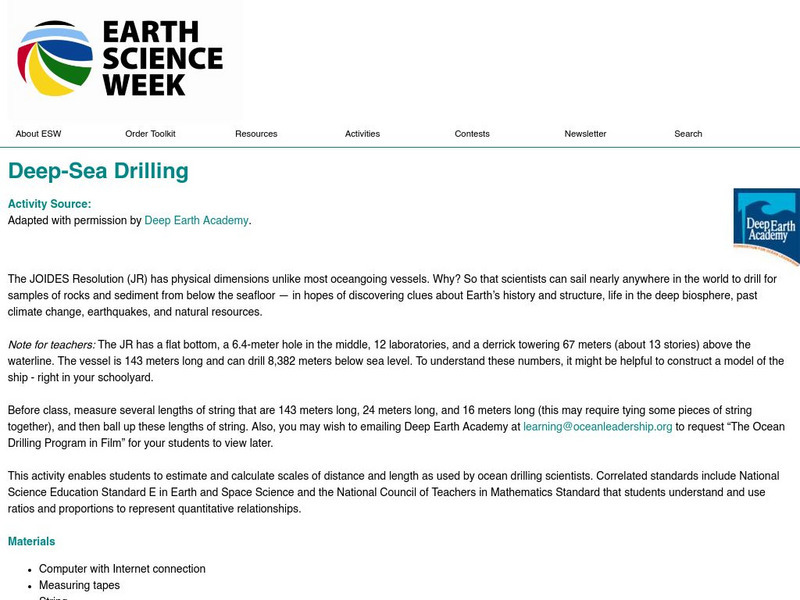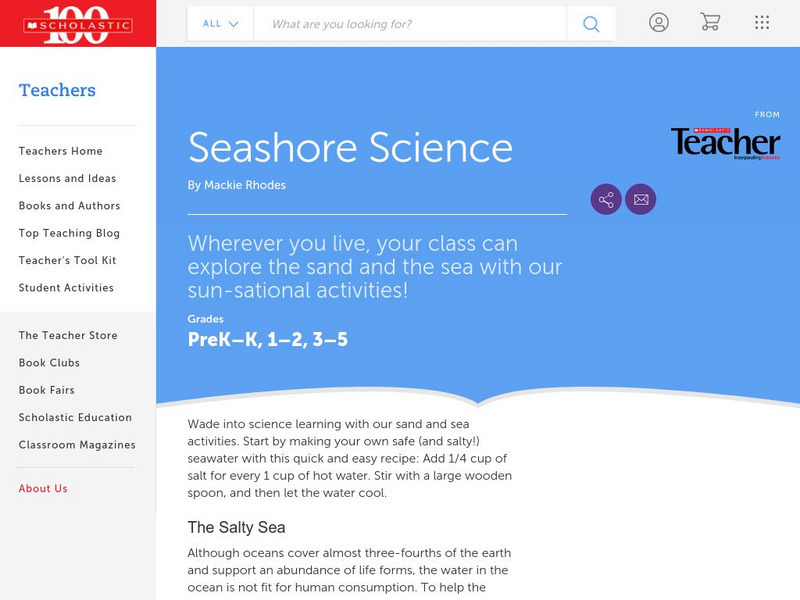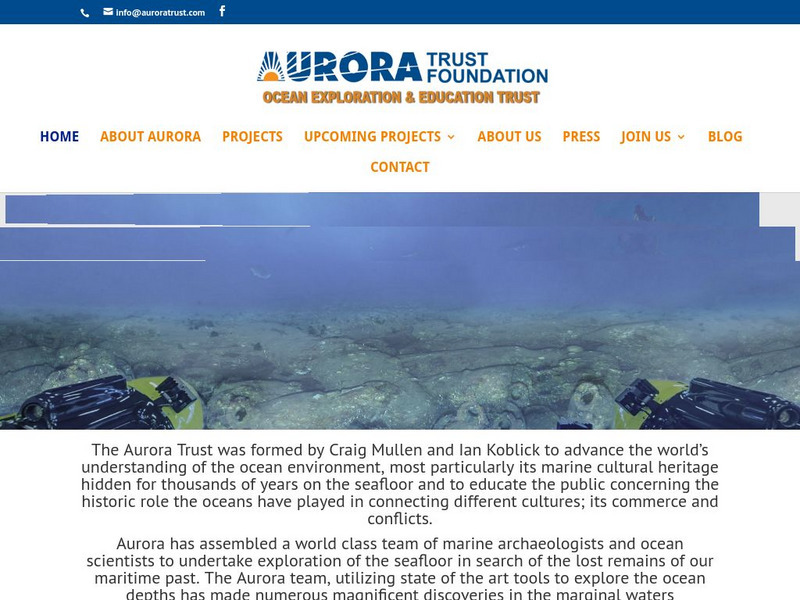TeachEngineering
Teach Engineering: Saltwater Circuit
Students build a saltwater circuit, which is an electrical circuit that uses saltwater as part of the circuit. Students investigate the conductivity of saltwater, and develop an understanding of how the amount of salt in a solution...
Woods Hole Oceanographic Institution
Woods Hole Oceanography Institute: Activity: Demo for Density
In this experiment, students look at Deep Hypersaline Anoxic Basins, or DHABs, that are present in the Eastern Mediterranean, and make a model of a DHAB to investigate how liquids that have different densities can form layers. This...
Science Education Resource Center at Carleton College
Serc: Mn Step: Sinking Water: Glaciers, Ocean Currents and Weather Patterns
A lesson where students learn how warm water is less dense than cold water, and what this means for global climate change as ice from the polar regions melts. Students will do experiments in buoyancy and water density when hot or cold,...
National Institute of Educational Technologies and Teacher Training (Spain)
Ministerio De Educacion: La Hidrosfera Terreste
In this site learn about the origin of water on Earth, water in other planets, the molecule of water, the sea water solution, the water on the continents and water and health. It contains many illustrations and 14 interactive activities.
PBS
Idaho Public Television: Ocean Murals
Integrative lesson plan incorporates math, science and art to teach children about the ocean and its inhabitants. Multiple activities included, approximately 4-6 days to complete. to other sources on oceans. References Bill Nye video...
Climate Literacy
Clean: El Nino and It's Impact on the World
The activity takes a hands-on approach to understanding El Nino by physically showing and feeling this weather phenomenon. It consists of an El Nino demo as well as an experiment to be conducted by the students themselves.
Museum of Science
Museum of Science: Water Density Experiment
A simple lab activity to demonstrate that ocean currents are influenced by changes in water density.
Science Education Resource Center at Carleton College
Serc: Density Differences
Students investigate differences in ocean water density, and record density data from salt, ice, and hot water samples in their notebooks. Students then simulate ocean water temperature levels in a simulation.
American Geosciences Institute
American Geosciences Institute: Earth Science Week: Deep Sea Drilling
In this activity, students learn about the JOIDES Resolution, an ocean-drilling vessel. They then use string to estimate the length of the ship and compare their estimates to the real length. They look at how deep the ocean water under...
NOAA
Noaa: The Ocean's Role in Weather and Climate
A collection of resources - interactive activities and teacher tutorials - on the impact the ocean has on weather and climate.
Other
Earth Science: Earth's Surface and Heat [Pdf]
This textbook chapter looks at the role of temperature in sustaining life on Earth and on weather and climate. It discusses the Earth's movements and the seasons, the circulation of the oceans, wind and weather, and the water cycle....
TeachEngineering
Teach Engineering: Oil on the Ocean
Students learn about oil spills and their environmental and economic effects. They experience the steps of the engineering design process as they brainstorm potential methods for oil spill clean-up, and then design, build, and re-design...
Scholastic
Scholastic Instructor: Seashore Science
Come and learn with this incredible seashore science resource. The content includes fun facts, experiments, reproducible activities, resources and more.
National Geographic
National Geographic: Sources, Sinks, and Feedbacks
Students will learn about how the Earth's carbon cycle works, as they examine the relationship between levels of carbon dioxide and water vapor in the atmosphere and the temperature of the ocean's surface. Includes online student...
Other
Aurora Trust and Aurora Institute of Maritime Studies
Find out about human interaction with the world's oceans through education support activities in the fields of ocean exploration, research, and education.
Other
Beloit College: K 12 Geology
This is a good source of basic information about density currents in water. It includes simple activities you can do to demonstrate these currents.
University Corporation for Atmospheric Research
Ucar: Introduction to the Atmosphere
A detailed overview of the Earth's atmosphere, with explanations about atmospheric properties, the structure of the atmosphere, its four layers, atmospheric processes, energy heat transfer, conduction and convection, and radiation. All...
Texas Instruments
Texas Instruments: Finding the % Salt in Seawater
In this experiment, students are asked to collect data in order to prepare a calibration curve showing the relationship between the percentage of salt and the mass of salt water. Using this graph, students will be able to determine the...
National Geographic
National Geographic: Human Impacts on Marine Species
Students learn about three examples of human impacts on marine life: migration patterns and shipping, algal blooms and water chemistry, and marine debris. Some of these impacts are due to human activity in the ocean, and some impacts on...
Massachusetts Institute of Technology
Mit: Blossoms: Will an Ice Cube Melt Faster in Freshwater or Saltwater?
Engage students in the study of the ocean and saltwater with these activities. Students will see that saltwater has different physical properties than freshwater - mainly density. This lesson can serve as a springboard into other...
NASA
Nasa: Oceanography
Join NASA in its study of oceanography and learn about the Earth system, the physical ocean, and life in the ocean. Try out the Giovanni: Earth Data Visualization Tool and access satellite-derived data to enhance the learning experience.
TeachEngineering
Teach Engineering: Engineering for the Earth
Young students are introduced to the complex systems of the Earth through numerous lessons on its natural resources, processes, weather, climate and landforms. Key earth science topics include rocks, soils and minerals, water and natural...
Woods Hole Oceanographic Institution
Woods Hole Oceanographic Institution: Tsunami: An Interactive Guide
A complete, interactive learning activity covering the science of tsunamis, preparedness, research, and historical tsunamis. Excellent animations and real, historical recordings of survivors allow the learner to experience what happens...
Texas Instruments
Texas Instruments: Jason: Pinniped Body Shape Conserving Warmth
From Shore to Sea: To survive in cold ocean environments an organism's body must be adapted to life under water. A body will cool very quickly when in contact with water. The body shape of an organism is one adaptation that helps to...




















